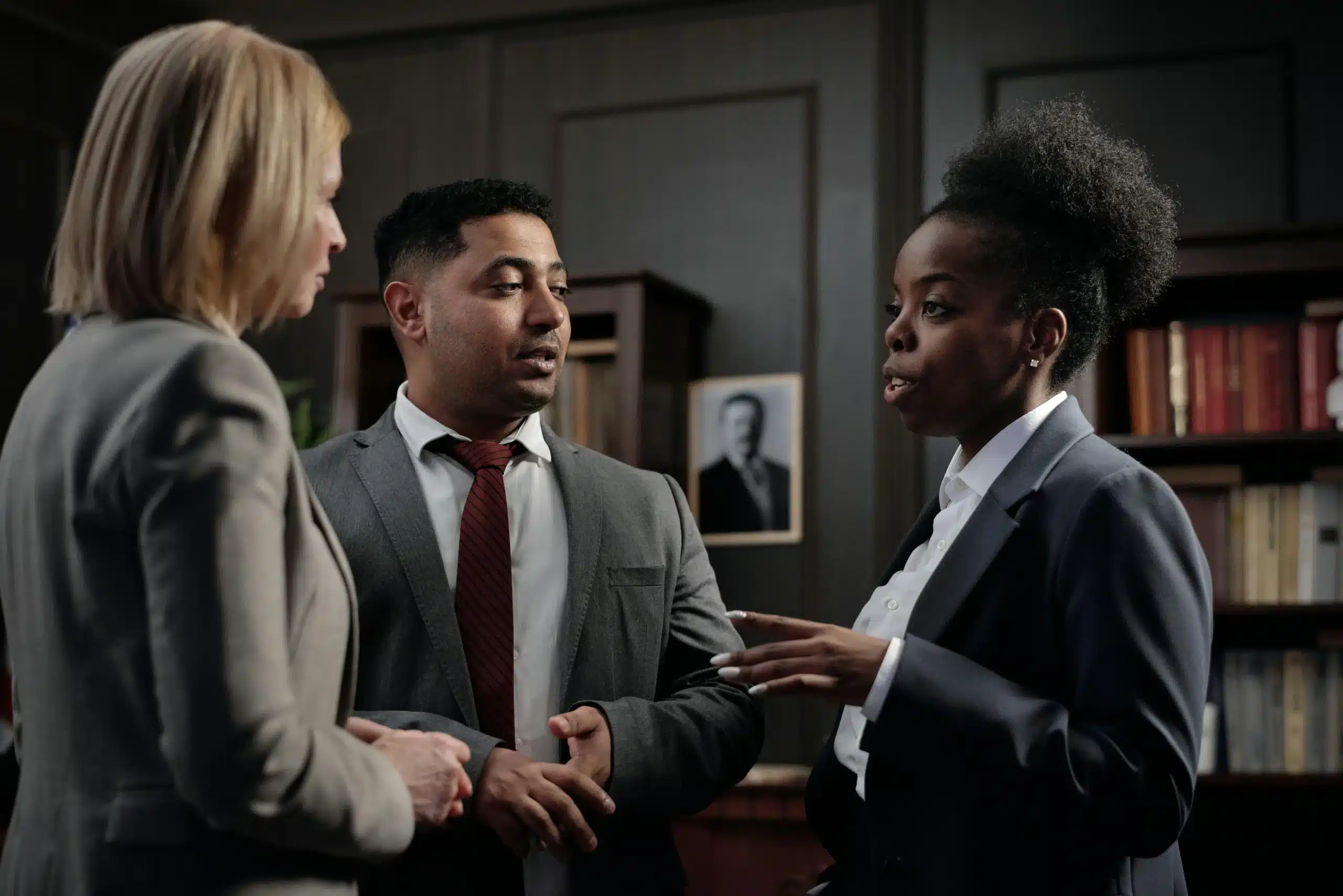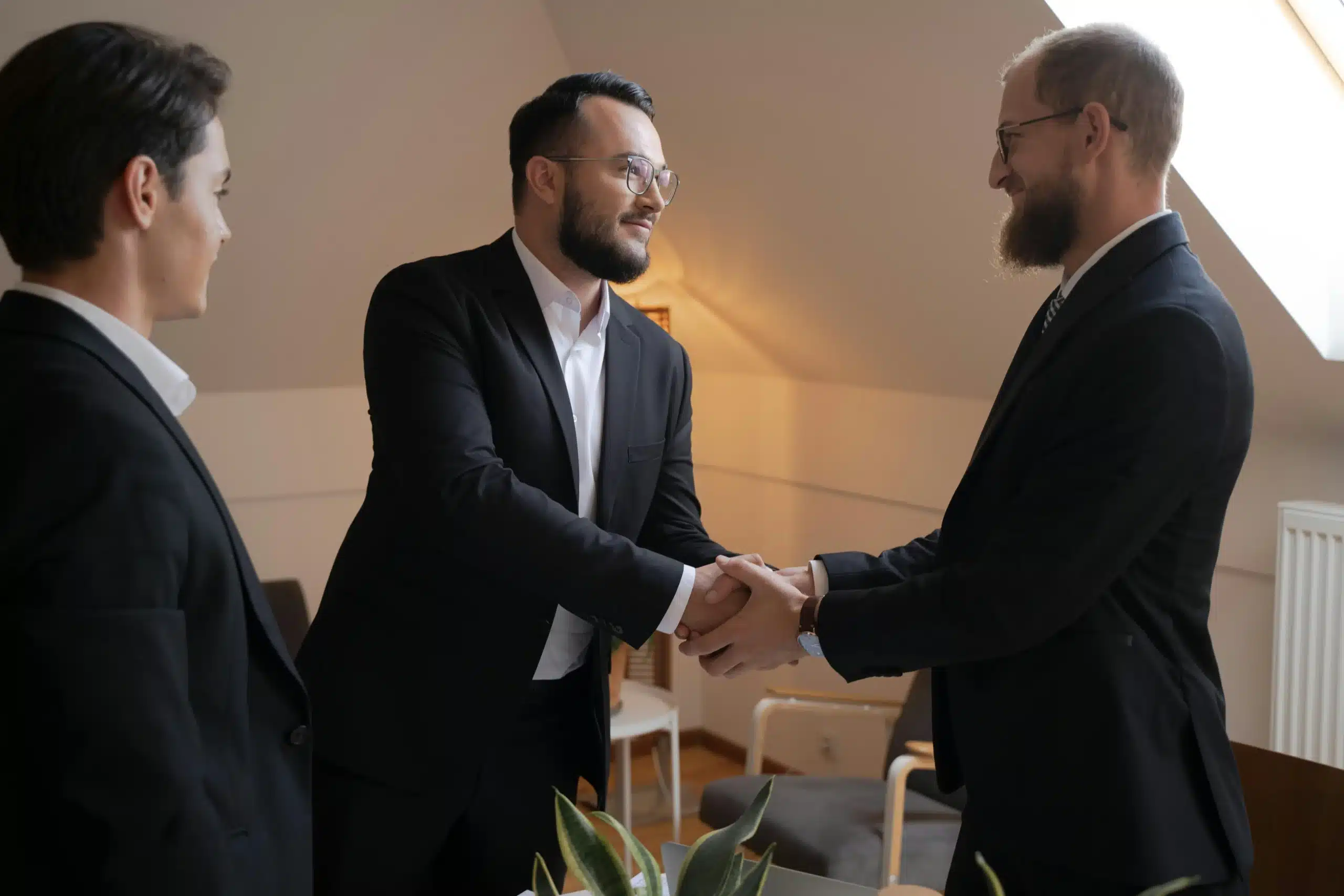In every company, from small teams to entire organizations, the need for effective conflict management stands out as a pillar of strength.
Conflicts, while often seen as hurdles, are also opportunities for growth and relationship building when addressed properly.
The following articles delve into the art of turning discord into constructive dialogues that pave the way for a more cohesive environment.
They offer a palette of strategies, each designed to handle the delicate threads of human interactions with care.
Keep reading to learn how to navigate the complexities of conflict and transform them into stepping stones for stronger connections.
Key Takeaways
- Understanding and Addressing Communication Breakdowns Is Crucial for Resolving Conflicts
- Personal Biases Can Hinder Conflict Resolution and Must Be Confronted for Effective Mediation
- Scarcity of Resources Often Escalates Conflicts, Requiring Collaborative Strategies
- Active Listening and Empathy Are Essential Skills for Managing and Resolving Disputes
- A Mediator’s Neutrality and Skill in Negotiation Can Guide Parties to Mutually Satisfactory Resolutions
Understanding the Roots of Conflict for Better Resolution

Tackling conflict head-on necessitates a deep understanding of its origins.
Pinpointing the common causes of disputes lays the foundation for effective conflict resolution strategies.
Often, when individuals struggle to bridge the chasm between their rights and those of others, tension brews.
This guide examines how a breakdown in communication can turn minor misunderstandings into full-blown conflicts.
It also highlights the way personal biases and perceptions shape the narrative, inflating disagreements to seemingly insurmountable proportions.
Furthermore, readers will grasp how scarcity of resources amplifies conflicts, pushing parties toward a tipping point where policy and soft skills in dialogue become invaluable tools for de-escalation.
By dissecting these key factors, one gains experience in recognizing the signals of a brewing storm and steering clear of the eye of the conflict.
Identifying the Common Causes of Disputes
Disputes often stem from a lack of fundamental skills in communication and understanding. Whether in personal relationships, on a professional website, or within a tight-knit work team, the ability to convey thoughts clearly and interpret messages accurately is crucial.
In the context of employment, differing opinions on job expectations and performance can lead to friction among staff. Leveraging insights from psychology, effective negotiation processes pave the way for resolving such disagreements and restoring harmony on the job.
| Conflict Domain | Key Skills for Resolution | Resources |
|---|---|---|
| Personal Relationships | Communication, Empathy | Books, Counseling |
| Professional Website Interaction | Clear Messaging, Feedback | Online Forums, Webinars |
| Employment Relations | Negotiation, Conflict Management | Workshops, Training Sessions |
The Role of Communication Breakdown in Conflicts
At the heart of many conflicts lies a breakdown in communication, often hampering conflict resolution before it truly begins. In business, a simple misinterpretation can escalate into a significant dispute, demanding swift intervention through mediation or alternative management strategies.
As parties become entrenched in their views, the role of open dialogue becomes more critical. Accounting for differences and finding a common language can turn discord into productive discussions, laying the groundwork for resolution and mutual understanding.
- Identify the root causes of communication breakdowns in conflicts.
- Implement mediation and management techniques to address and resolve disputes.
- Emphasize the importance of clear communication and accounting for diverse perspectives to prevent misunderstandings.
How Personal Biases and Perceptions Fuel Disagreements
Understanding how personal biases color interactions is key to unlocking happiness and preventing disputes in the workplace. Biases often act as filters, warping the true intent behind words and actions, which can lead to a breakdown in collaboration and, ultimately, affect productivity.
A person’s mindset plays a critical role in conflict resolution, as preconceived notions and subjective perceptions can create barriers to understanding others’ viewpoints. Addressing these internal biases is essential for fostering an environment where dialogue can thrive, and solutions can be found.
The Impact of Resource Scarcity on Conflict Escalation
When resources are limited, people compete and conflicts can arise. For a fair outcome, outside help may be needed. Managers and team leaders help shift the focus from individual losses to collective gains, and encourage collaboration and conflict resolution.
Embracing Active Listening for Conflict De-Escalation

In resolving conflicts, the art of active listening serves as a cornerstone for understanding and empathy.
It’s not just about the information exchanged; it’s about truly grasping the emotion behind the words.
Mastering active listening involves more than being silent while someone speaks—it means engaging fully to fathom the depth of the other person’s perspective.
By learning to decode not just the verbal cues, but also the non-verbal signals, individuals can navigate through emotional statements to identify the core issue at hand.
Active listening fosters an atmosphere where open dialogue is encouraged, leading to a shared understanding between conflicting parties—paving the way for a resolution grounded in mutual respect.
The Basics of Active Listening in Conflict Situations
In workplaces, good communication among leaders is crucial. Active listening is key. It helps leaders and team members understand each other better. It also builds trust. Using active listening regularly helps resolve conflicts. It shows an effort to understand and address the real issues causing disputes. This goes beyond just hearing words.
Techniques for Showing Empathy and Understanding
Understanding and acknowledging each person’s thoughts and feelings is important in resolving conflicts. When people feel heard and understood, they are more likely to work together towards a common goal. This creates an environment where new ideas can thrive without being held back by resistance or resentment.
In human interactions, especially within marketing teams, showing understanding is crucial for bringing people together and setting common goals. By recognizing each team member’s contributions and understanding their challenges, leaders can create a sense of belonging and mutual respect. This is essential for working through conflicts and guiding projects to success.success.
Navigating Through Emotional Statements to the Core Issue
When resolving conflicts, it’s important to address the real issues by navigating emotional challenges. Leaders should use strategies that go beyond surface-level problems and adapt to each situation to encourage creativity and move their business forward.
A conflict resolution strategy that looks into the actual causes of disagreements can turn conflict into a driver of business growth. By focusing on the primary concerns and setting aside emotional distractions, team members can work together effectively on innovative solutions.
Encouraging Open Dialogue and Mutual Understanding
Creating an environment that nurtures open dialogue involves setting aside personal bias, ensuring every mind at the table feels valued. When teams incorporate this ethical approach, they foster a foundation for mutual understanding that benefits all involved, strengthening the collaborative spirit crucial for entrepreneurship.
By addressing and acknowledging different viewpoints without prejudice, leaders encourage a culture where open communication is the norm. This climate of acceptance empowers individuals to share insights freely, a practice that plays a pivotal role in resolving conflicts and driving innovation in diverse settings.
The Power of Mediation in Resolving Disputes

Mediation stands as a critical method for unraveling the intricacies of organizational conflict, offering a structured approach that harnesses the power of neutrality to transform discord into constructive dialogue.
With the advancement of technology, the pool of mediators expands, offering diverse backgrounds and knowledge pivotal for addressing unique conflict scenarios.
The right mediator brings an unmatched level of development in the art of negotiation, possessing the intelligence to facilitate meaningful exchanges that lead parties from entrenched opposing positions to a mutually satisfying agreement.
Understanding this, the mediation process unfolds through calibrated steps that channel the complexities of interpersonal or enterprise disputes into a streamlined path to resolution.
Choosing the Right Mediator for Your Conflict Scenario
Securing a mediator who is adept at problem solving and possesses relevant health or education experience can make a significant difference. Such a professional brings a dual understanding of conflict dynamics and the nuances of the particular field, ensuring a balanced and insightful approach to dispute resolution.
Moreover, a mediator with a strong grasp of emotional intelligence can navigate sensitive issues with care. They play a critical role in maintaining a respectful environment, where all parties feel acknowledged and solutions are forged with empathy and consideration for all involved.
Steps in the Mediation Process: From Opening to Agreement
The mediation process begins with a phase of opening statements, where the mediator establishes the groundwork for cooperation and sets the tone for respectful dialogue. In this initial stage, parties are encouraged to share their perspectives without interruption, ensuring that the mediator comprehensively understands the distinct positions and interests at play.
As the mediation progresses, the emphasis shifts to collaborative problem-solving, with the mediator guiding the conversation towards potential compromises. The final phase is marked by the crafting of an agreement that honors the needs and expectations of all involved, often with the mediator synthesizing the discussion into a clear, actionable plan that resolves the conflict.
How Mediators Facilitate Productive Conversations
Mediators wield the delicate art of objectivity to unravel the threads of a dispute, creating a space where each party can speak without the fear of bias. They listen intently, ask probing questions, and restate the issues, ensuring clarity and preventing the common misunderstandings that often stoke the fires of conflict.
Through their skillful management of the conversation, mediators help keep the focus on the common ground rather than the divisions. They encourage each person to explore alternatives and consider the other’s perspective, gently steering the dialogue towards a resolution that everyone can accept and support.
The Benefits of a Neutral Third Party in Conflict Resolution
The inclusion of a neutral third party in conflict resolution introduces an atmosphere free from partiality. This independence is vital for the trust of all stakeholders involved, as it reassures them that decisions and suggestions arise from an unbiased viewpoint.
A mediator operates outside of the existing power dynamics, facilitating discussions without the risk of favoritism or vested interests. By providing this external perspective, they aid in unveiling solutions that may have been obscured by internal politics or emotions.
- Reassures stakeholders of unbiased resolution processes.
- Facilitates equitable discussions, irrespective of internal power dynamics.
- Identifies solutions unaffected by internal politics or emotions.
Developing Effective Negotiation Skills

Mastering the art of negotiation is pivotal when navigating the complex landscape of conflict resolution.
This journey begins with preparation, where setting clear goals, understanding the needs of all parties, and planning concessions shape the roadmap to success.
As negotiators dive into this process, they often discover that the objective isn’t just to win, but to craft outcomes where all sides gain valuable benefits—a delicate balancing act known as win-win negotiation.
Along the way, they’re bound to encounter hard bargainers and deadlocks, challenging their ability to stay poised and find inventive solutions.
The ultimate challenge lies in securing agreements that stand the test of time, creating a durable peace that allows all stakeholders to move forward with confidence.
Preparing for a Negotiation: Goals, Needs, and Concessions
Entering a negotiation well-prepared is the linchpin of successful conflict resolution. Individuals must clarify their own goals, an essential step that aligns their objectives with the negotiation’s priorities and outcomes.
Understanding the needs and interests of all parties transforms a negotiation from a battleground to a mutually beneficial problem-solving session. This awareness shapes strategies and helps negotiators anticipate areas where concessions might be necessary to reach a compromise.
Strategies for Win-Win Negotiations
Engaging in win-win negotiations involves identifying shared interests and expanding the pie rather than fighting over a single piece. It requires negotiators to dig deep, discovering and appealing to the common values and goals that might not be initially apparent. This tactics shifts the focus from a zero-sum game to creating additional value that benefits all sides involved.
To craft a win-win scenario, effective communication and creative thinking are paramount. Negotiators must listen actively to each other’s concerns and propose solutions that can satisfy the various interests at stake. Only by truly understanding the underlying needs of all parties can they design agreements that everyone can endorse.
Dealing With Tough Negotiators and Stalemates
When facing tough negotiators, the key lies in maintaining composure and approaching the dialogue with a strategic mindset. Listening attentively and understanding the other party’s position while steadfastly communicating your interests and boundaries is essential.
Encountering a stalemate can be challenging, but it opens the door for creative problem-solving and the possibility of exploring alternative solutions. Patience and the willingness to approach the negotiation table with flexibility can break the deadlock, leading to an eventual consensus:
| Negotiation Challenge | Strategies for Resolution |
|---|---|
| Demanding Negotiators | Active Listening, Clear Boundaries |
| Negotiation Stalemates | Creative Problem-Solving, Flexibility |
Closing Negotiations With Lasting Agreements
Successful negotiation depends on making agreements that truly reflect each party’s needs and desires. These agreements serve as a plan for future interactions, promoting ongoing cooperation and reducing potential for conflict. They represent the hard work put in by each party to reach a positive outcome.
| Component of Lasting Agreement | Description | Impact |
|---|---|---|
| Understanding Needs | Terms align with the core needs of involved parties | Ensures long-term satisfaction and adherence |
| Enduring Cooperation | Agreements are designed to facilitate continuous collaboration | Reduces chance of future disputes |
| Reflective of Negotiation Spirit | Terms capture the essence of the collective negotiation effort | Encourages respect and commitment to the agreement |
Implementing Collaborative Problem Solving

Moving from conflict to collaboration is crucial for resolving conflicts.
All parties need to make an effort to identify shared goals and interests.
Once these commonalities are recognized, working together to find new solutions becomes important.
Success depends on not only reaching agreements, but also on using effective strategies to enforce and maintain these agreements over time.
Transitioning From Conflict to Collaboration
Transitioning from a state of conflict to one of collaboration is an intricate process that requires a fundamental shift in outlook. It necessitates parties involved in a dispute to adopt a forward-thinking mindset, focused on forging alliances rather than emphasizing divides.
Shifting the dynamics from adversarial to cooperative hinges on a willingness to empathize and communicate openly. Recognizing the value in each other’s viewpoints paves the way for a unified approach to overcoming obstacles and achieving shared objectives.
Identifying Shared Goals and Interests in Conflict Situations
When resolving conflicts, it’s important to find common goals. Both parties need to understand each other’s perspectives to discover shared hopes and benefits that can help resolve the issue.
| Conflict Aspect | Approach to Identify Shared Interests | Expected Outcome |
|---|---|---|
| Communication Breakdown | Structured dialogue sessions | Restored communication channels |
| Resource Allocation | Joint needs assessment and prioritization | Equitable distribution strategy |
| Process Disagreements | Comparative analysis of methodologies | Hybrid process incorporating best practices |
Once common ground is established, it forms a platform for building solid agreements. It instills a sense of ownership and investment in the resolution, fostering a commitment to abide by the consensus long after the discussions have ended.
Techniques for Brainstorming Solutions Together
Brainstorming solutions together calls for a dynamic blend of open-mindedness and structured interaction. Everyone must feel at ease to present their ideas without judgment, encouraging a rich tapestry of perspectives to surface.
The process is spearheaded by a facilitator who steers the group’s energy toward generating and refining various strategies. Effective facilitation ensures that the brainstorming stays on course and every voice is heard.
Strategies for Implementing and Sustaining Collaborative Agreements
Embedding collaborative agreements within organizational culture begins with clear communication and documented commitments. Ensuring that all parties understand and align with agreed-upon terms is critical, forming a transparent foundation that strengthens trust and collective accountability over time.
Regular follow-ups and review sessions help sustain collaborative agreements, allowing teams to assess progress and address new challenges that arise. This ongoing dialogue keeps the focus on shared goals and maintains the agility needed to adapt agreements as necessary, fostering a durable cooperative environment.
Cultivating a Positive Conflict Culture in Teams

Teams naturally experience conflicts, but how they are addressed can affect the organization’s culture.
Creating a positive culture of conflict resolution within teams involves building trust and respect, and providing the necessary skills for navigating interpersonal difficulties.
Leadership sets an example by demonstrating conflict resolution in action, which encourages team members to do the same.
Recognizing and celebrating successes in conflict resolution reinforces these practices within the team’s culture, making constructive engagement and celebrating collaborative achievements the new standard.
Building a Foundation of Trust and Respect
To effectively resolve conflicts within a team, it’s important to build trust. Team members should feel comfortable expressing their thoughts and concerns, creating an environment for open and honest communication.
Respect is shown when team leaders and members listen to each other and value diverse viewpoints. This mutual respect sets the stage for constructive interactions and helps address conflicts in a supportive and non-confrontational manner.
Training Teams in Conflict Resolution Skills
Equipping team members with the right tools to handle conflicts transforms the workplace into a harmonious environment. Training sessions that focus on effective communication, empathetic listening, and collaborative problem-solving can empower individuals with diverse backgrounds to navigate through disagreements constructively.
Seasoned trainers use real-life scenarios to teach teams the nuances of conflict resolution, ensuring that lessons are well understood and practical. These tailor-made workshops serve to solidify a team’s capability to deal with conflicts internally, fostering a self-sufficient and resilient workforce.
The Role of Leadership in Modeling Conflict Resolution
Leaders act as vital touchstones for conflict resolution approaches within teams. Their behavior in the face of discord sets a powerful precedent for team member interactions, underlining the principles and practices the whole group should adopt.
By openly engaging in resolution strategies and acknowledging the complexities of conflict, leaders embody the transparent and proactive communication, crucial for a healthy team dynamic. They not only instruct but inspire, fostering a workplace where disputes are navigated thoughtfully and constructively.
| Leadership Approach | Impact on Team Culture |
|---|---|
| Engagement in Resolution Strategies | Sets behavioral standards for team members |
| Transparent Communication | Builds trust and fosters open dialogue |
| Acknowledgement of Conflict Complexities | Encourages a proactive and informed approach to disputes |
Celebrating Conflict Resolution Successes to Reinforce a Positive Culture
Highlighting achievements in conflict resolution reinforces a culture where these skills are valued and celebrated. When teams take the time to recognize individuals and groups for successful mediation and collaborative problem-solving, they underline the importance of these efforts as essential to the health and success of the organization.
Such recognition can take many forms, from public commendations at meetings to written acknowledgment in company communications. These gestures of appreciation not only validate the work put into resolving disputes but also serve as a powerful motivator for continued positive interactions and a commitment to maintaining a harmonious workplace.
Conclusion
Effective conflict resolution hinges on understanding and addressing the underlying causes of disputes, with communication breakdowns and personal biases being significant contributors.
Active listening, empathy, and proper negotiation techniques play pivotal roles in de-escalating tensions and fostering an environment conducive to collaborative problem solving.
Mediation by a neutral third party can bridge divides, ensuring solutions are unbiased and respected by all stakeholders.
Ultimately, cultivating a positive conflict culture within teams galvanizes trust, respect, and the commitment to transform discord into constructive collaboration.




